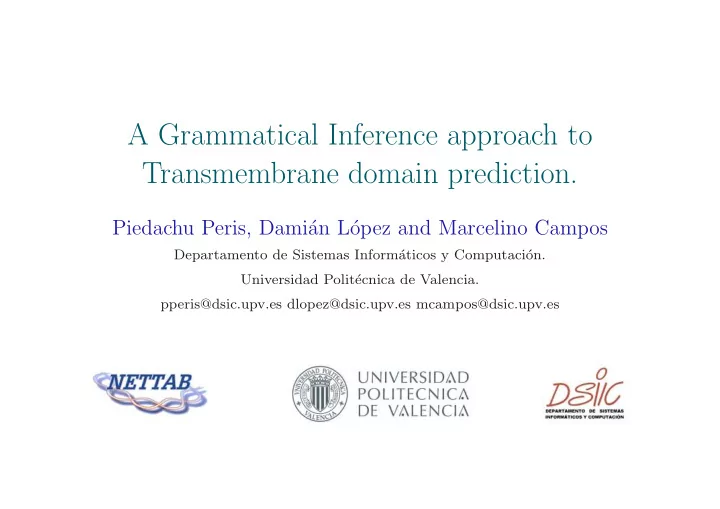

A Grammatical Inference approach to Transmembrane domain prediction. Piedachu Peris, Dami´ an L´ opez and Marcelino Campos Departamento de Sistemas Inform´ aticos y Computaci´ on. Universidad Polit´ ecnica de Valencia. pperis@dsic.upv.es dlopez@dsic.upv.es mcampos@dsic.upv.es
Introduction Transmembrane proteins: Involved in: • Communication between cells • Transport of ions and nutrients • Reception of viruses • Diabetes, hypertension, depression, arthritis, cancer... 1
Introduction Prediction of transmembrane regions in proteins. Different approaches: • Hidden Markov Models: ◦ Sonnhammer E. et al.: TMHMM • Neural Networks: ◦ Fariselli P. et al.: HTP • Statistical analysis: ◦ Pasquier C. et al.: PRED-TMR Our approach (igTM): Based on Grammatical Inference. 2
Preliminary concepts (I) Alphabet: Σ = { a, b, c, d, e, f, g } ∆ = { A, B, C, D, E, F, G, H, I, K, L, M, N, P, Q, R, S, T, V, W, Y, Z } Word: u = abababab w = abcddabfged fc v = MNY IFDLSILLV V A Language: L 1 = { a n b n : n ≥ 1 } L 2 = { transmembrane proteins sequences } f m a n : m ≥ 1 n ≥ 0 } L 3 = { d 3
Preliminary concepts (II) Finite automaton: a a b Transducer: a/0 a/0 p=1 p=0.8 a/1 a/1 b/1 b/1 p=0.2 4
Grammatical Inference (GI) Goal: Learn a language from a sample of words. S = { aab, aaaab, aaaaaab } Different GI algorithm → different language: L a = { a n b : n ≥ 1 } L b = { a n b : n ≥ 2 } L c = { ( aa ) n b : n ≥ 1 } Greater alphabet → more difficult to learn a language. 5
Method 1. Words: Set of proteins (sequences of amino acids) W = { MDAIKKM, GDAV KK, MDAAIKKM } 2. Alphabet reduction: Dayhoff Amino acid Dayhoff MDAIKKM GDAVKK MDAAIKKM C a G, S, T, A, P b ecbedde bcbedd ecbbedde D, E, N, q c 3. Domain and topology annotation: R, H, K, d L, V, M, I e ecbedde bcbedd ecbbedde Y, F, W f iiMMMoo ooMMMi iiiMMooo B, Z g 6
Method (II) 4. GI process: Inference of a probabilistic transducer: input: protein + annotation (each symbol related to its label): [ei][ci][bM][eM][dM][do][eo] [bo][co][bM][eM][dM][di] [ei][ci][bi][bM][eM][do][do][eo] d/o 1/3 e/o 2/3 b/i 1/2 c/i e/i 2/3 d/o 1/3 b/M b/M 1/2 d/o 1/2 b/o 1/3 d/M 2/3 c/o b/M e/M d/i 1/2 output: annotation of words (proteins): iiMMMoo ooMMMi iiiMMooo 5. Test phase: returns the transduction that is most likely produced by the input string. input: MDAIKKKHL → ecbedddde output: iiiMMoooo 7
Databases We used three datasets to train and test our method: TMHMM database: set of 160 transmembrane proteins, available at: http://www.cbs.dtu.dk/ ∼ krogh/TMHMM . TMPDB: set of 302 transmembrane proteins, available at: http://www.genome.jp/SIT/tsegdir/whatis tmpdb.html . 101-pred-TMR db: Set of 101 transmembrane proteins, used to elaborate the pred-TMR prediction method. We downloaded each of the proteins from Uniprot web page. 8
Performance measures T P Sensitivity (Sn) S n = T P + F N T P Specificity (Sp) S p = T P + F P Correlation coefficient (CC) ( T P × T N ) − ( F N × F P ) √ CC = ( T P + F N ) × ( T N + F P ) × ( T P + F P ) × ( T N + F N ) Average conditional probability (ACP) � � ACP = 1 T P T P T N T N T P + F N + T P + F P + T N + F P + 4 T N + F N Approximated correlation (AC) AC = ( ACP − 0 , 5) × 2 9
Experimentation Encoding and annotation of an example sequence for each different experimental configuration: Sequence: MRVTAPRTLLLLLWGAVALTETWAGSHSMR Dayhoff: edebbbdbeeeeefbbebebcbfbbbdbed TM domains: 4-10, 20-25 exp1: edebbbdbeeeeefbbebebcbfbbbdbed...MMMMMMM.........MMMMMM..... exp2: edebbbdbeeeeefbbebebcbfbbbdbedoooMMMMMMMiiiiiiiiiMMMMMMooooo exp3: edebbbdbeeeeefbbebebcbfbbbdbedoooNNNNNNNiiiiiiiiiPPPPPPooooo exp4: edebbbdbeeeeefbbebebcbfbbbdbedOOONNNNNNNiiiiIIIIIPPPPPPooooo exp5: edebbbdbeeeeefbbebebcbfbbbdbedooCMMMMMMMDiiiiiiiAMMMMMMBoooo exp6: MRVTAPRTLLLLLWGAVALTETWAGSHSMRoooMMMMMMMiiiiiiiiiMMMMMMooooo 10
Results - TMHMM database TMHMM database Sn Sp AC 0.795 0.808 0.692 exp2 0.820 0.794 0.703 exp3 0.748 0.801 0.656 igTM exp4 0.808 0.702 exp5 0.810 0.819 0.796 exp6 0.707 0.900 0.879 0.827 TMHMM 0.786 0.898 0.767 Pred-TMR 0.832 0.854 0.768 S-TMHMM 11
Results - TMPDB TMPDB Sn Sp AC 0.675 0.757 0.538 exp1 0.690 0.751 0.542 exp2 0.670 0.741 0.530 exp3 0.601 0.735 0.476 igTM exp4 0.683 0.750 0.539 exp5 0.710 exp6 0.759 0.557 0.739 0.831 0.659 TMHMM 0.777 0.899 0.756 Pred-TMR 0.737 0.829 0.659 S-TMHMM 12
Results - 101-PRED-TMR-DB 101-PRED-TMR-DB Sn Sp CC AC 0.810 0.811 0.702 0.702 exp2 0.758 0.781 0.667 0.652 exp3 0.693 0.795 0.640 0.618 igTM exp4 0.793 0.697 0.692 exp5 0.821 0.801 0.820 exp6 0.855 0.709 0.899 0.871 0.822 0.817 TMHMM 0.814 0.909 0.792 0.795 Pred-TMR - - 0.77 - WaveTM - - 0.82 - HMMTOP 0.831 0.840 0.772 0.760 S-TMHMM 13
Conclusions and future work Results in line with those existing in literature This system does not need any biological knowledge. Method can be tested online at: http://esparta.dsic.upv.es:8080/code/igtm.php Future work: • use this method together with another one, based on HMM, to perform better. • train this method with another (larger if possible) databases (e.g.: http://opm.phar.umich.edu/) • new inference algorithms 14
Thank you! Any question? 15
Recommend
More recommend